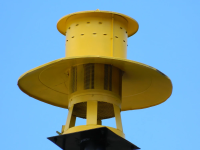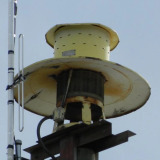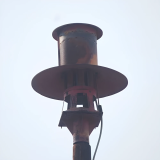5V
| Model 5V | |
 A refurbished Model 5V, located in Poplar Springs, SC. Image credit to Christopher Jansce. | |
| Company | Sentry Siren |
|---|---|
| Produced | 1980-2000 |
| Type | Omnidirectional Electromechanical |
| Sound output | 112 dB @ 100 ft |
| Horsepower | 7.5 hp |
| Voltage | 208-230/460 V AC 1 or 3 ph |
| Preceded by | Model M |
| Succeeded by | Model 7V8 |
| Documentation | Product sheet |
The Model 5V is a small omnidirectional siren that was produced by Sentry Siren. It was one of Sentry's original sirens and was produced for a period of 20 years before its discontinuation. It would be replaced by the Model 7V8 in the year 2000, which offered better performance.
History and Design

The Model 5V was introduced in 1980 alongside Sentry's other 1980 lineup following the success of the earlier Model 10V2T, which included the Model 3V8, Model 10V, and Model 20V2T. The Model 5V is a very basic siren in terms of design, using an 8-port single tone rotor and stator which is heavily based on the Sterling Model M's, driven by a 7.5 hp AC motor on top of the siren. While the siren came in 8-port by default, 16-port single tone was available by special order. Only 5 existing examples are known to be 16-port, and it's unlikely that many more were ever made to begin with. The siren's design is very basic, with the rotor and stator being attached to a 6-legged mount which has a cone to project the sound from the intake outwards.
The motor itself is placed inside a weatherproof housing, and the siren comes with a large skirt above the rotor and stator to direct sound outwards and protect everything below it from the elements. This makes it similar in appearance to the Model 3V8, though the Model 5V has a significantly larger skirt and slightly taller proportions. Due to the relatively flimsy build of the skirt, it is prone to warping, as is seen on many Model 5V units. The rotor, stator, and intake are protected using mesh screens. This simple design allows the siren to be both cheap and easy to maintain. The Model 5V was available in either 1 or 3 ph AC, with 1 ph units using a centrifugal regenerative brake which slows the rotor down rapidly when the rotor reaches a low enough rpm in order to recharge the motor's capacitor. The motor housing is identical in height for both 1 and 3 ph units, unlike the Model 3V8. The siren is able to reach 112 dB at 100 ft according to Sentry. While the siren was made out of regular steel, corrosion resistant stainless steel was also an option, best suited for coastal areas.
The Model 5V was eventually discontinued in the year 2000, when Sentry began to streamline their preexisting lineup. The Model 5V and the newly introduced Model 7V8 had very similar production costs and performance, which led to Sentry choosing to discontinue the Model 5V. Having been discontinued over 20 years ago, the Model 5V is an uncommon sight compared to Sentry's other, newer sirens. The majority are 8-port, while 5 16-port units are also known to exist.
Model 7V

A supposed Model 7V was also rumored to exist, although little to no evidence exists to support this claim, aside from a Model 5V-adjacent siren with a taller motor housing than normal, located in Nanticoke, PA. According to an unverified claim made by Dave Fritz of the Siren Enthusiasts Facebook group, the Model 7V was introduced alongside the Model 5V in 1980 and offered for a brief period of time before being phased out of Sentry's lineup due to its unpopularity. Another claim made on the Siren Board also claims that the Model 7V existed at one point, which was identical to the Model 5V minus a larger rotor and stator and a 7.5 hp motor. As the Model 5V itself was 7.5 hp, it would make little sense for a Model 7V as described by either of these claims to exist. Absolutely no documentation from Sentry exists regarding a Model 7V, and it can be assumed that it most likely never existed.